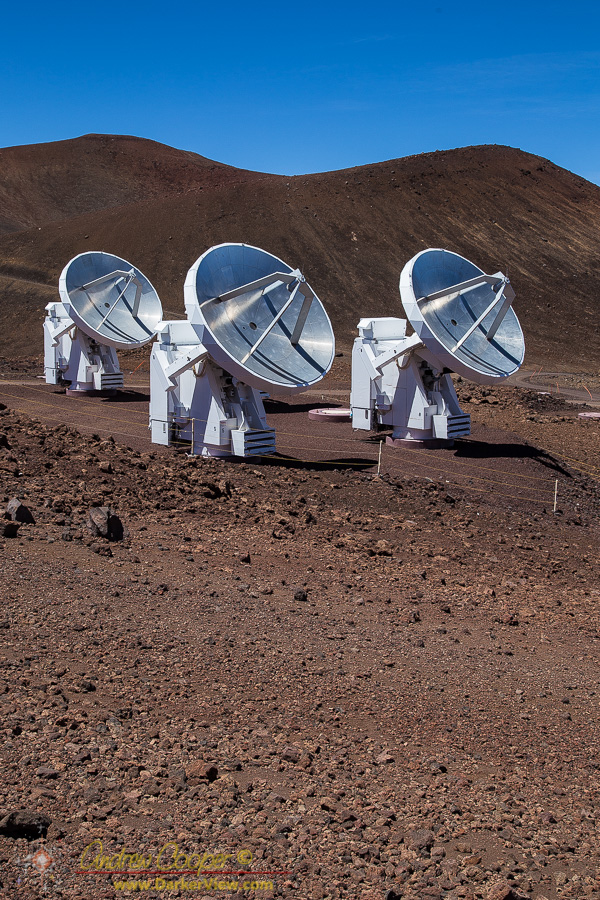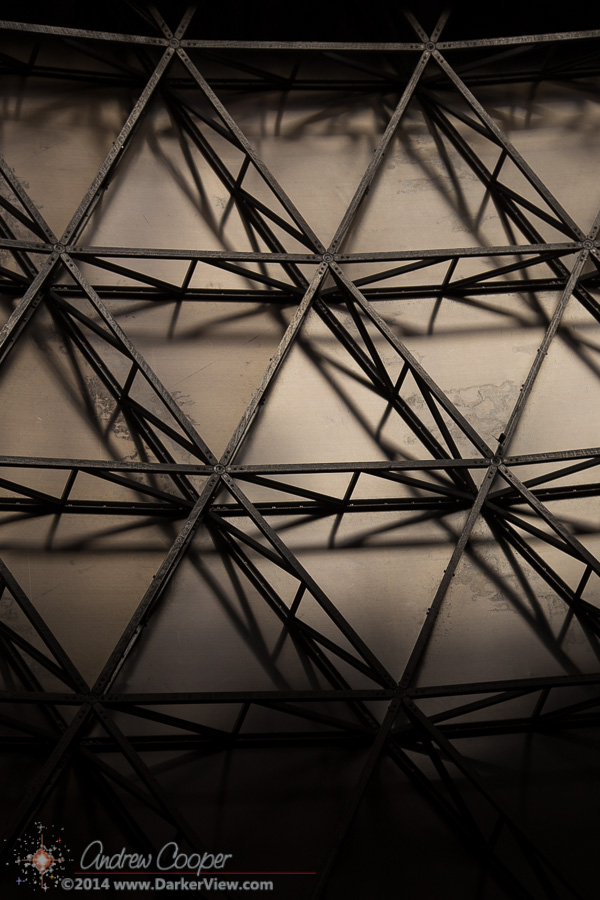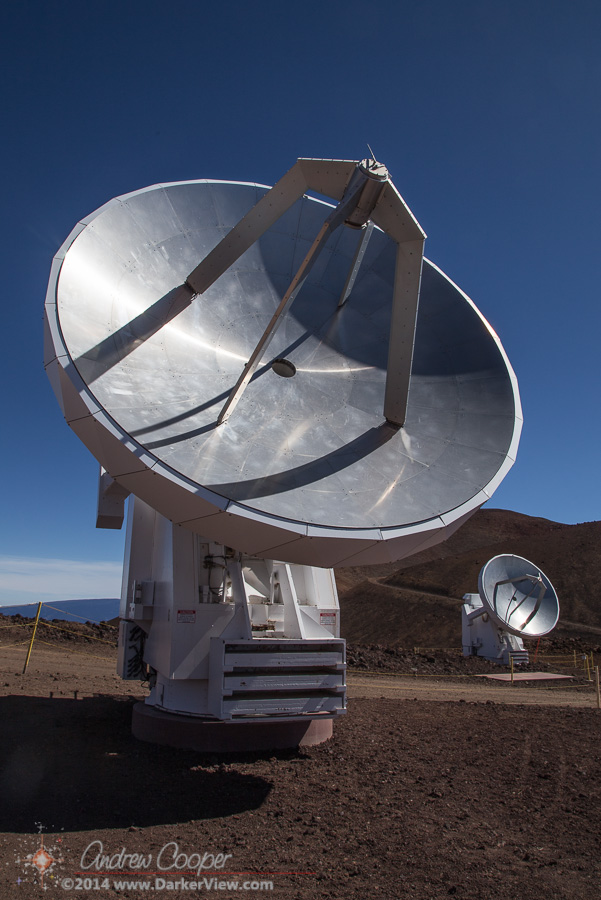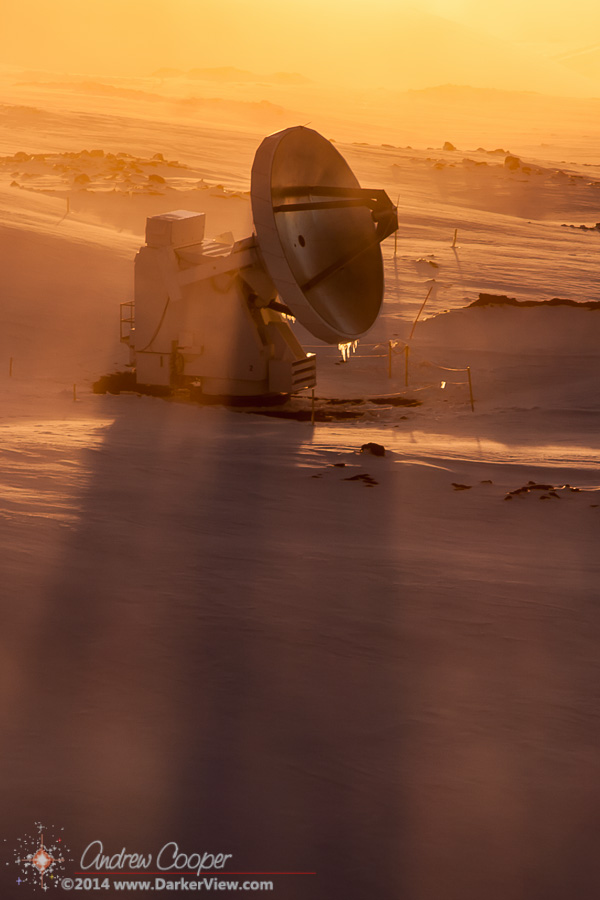
Tag: submillimeter
SMA
Caltech Submillimeter Observatory in Hawaii to End Operations
We have known this was coming for some time. With ALMA coming online the Caltech Submillimeter Observatory is looking decidedly obsolete. It’s closure was announced a few years back as Caltech planned to reallocate the budget.
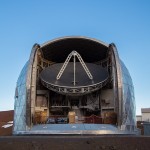
Last year I arranged a tour of CSO for the members of WHAC. It was great to get a good look at this facility before it becomes part of history.
After almost 29 years, the California Institute of Technology (Caltech) will end operations of the Caltech Submillimeter Observatory (CSO) in Hawaii in September, 2015. As previously announced, Caltech will begin the planning for the dismantling of the observatory. This process will be planned in close coordination with the Office of Mauna Kea Management, University of Hawaii at Hilo, to ensure that it is undertaken promptly and in a culturally and environmentally respectful manner. Caltech is sincerely grateful to the people of Hawaii Island for the use of Maunakea for nearly three decades, enabling superb research from this excellent astronomical site for the betterment of humanity. Caltech commits to the dismantling of the telescope and site restoration according to the Decommissioning Plan approved by the Board of Land and Natural Resources.
The CSO is a cutting-edge facility for astronomical research and instrumentation development. The CSO’s 10.4-meter radio telescope was designed and assembled in the 1980s by a team led by the late Robert Leighton, Caltech’s Valentine Professor of Physics. Under the leadership of CSO founding director Tom Phillips, the John D. MacArthur Professor of Physics, Emeritus, at Caltech, new instrumentation for the CSO was developed over the years by Caltech faculty, students, and staff; by staff scientists from NASA’s Jet Propulsion Laboratory (which is managed by Caltech); and by collaborators at institutions around the world.
Located near the summit of Mauna Kea, the CSO began operation in early 1987, under the management of Caltech by agreement with the University of Hawaii. For nearly three decades, astronomers from around the world have used the observatory to pursue research and to accomplish groundbreaking achievements in submillimeter and millimeter astronomy—the study of light emitted by atoms, molecules, and dust grains in the interstellar space where stars and planets form. Well over 100 students, from Caltech and other institutions, have used the CSO for their PhD research.
“The CSO has played a central role in the development of the science and instrumentation of submillimeter and millimeter astronomy over the last three decades,” says Sunil Golwala, current director of the CSO and a professor of physics at Caltech. “The CSO legacy of combining training in instrumentation development, hands-on observing, and science will live on via its former students and researchers as well as in new projects for which it has laid the foundation.”
“This has been a most exciting time in which the field of submillimeter astronomy has been developed, leading to an understanding of astrochemistry, star formation, and distant, dust-obscured galaxies,” says Phillips, now the CSO’s director emeritus. “We thank the National Science Foundation, which funded the CSO continuously from construction in 1984 to the end of 2012.”
“The CSO has been foundational in creating the thriving discipline of submillimeter astronomy,” says Tom Soifer (BS ’68), Kent and Joyce Kresa Leadership Chair of Caltech’s Division of Physics, Mathematics and Astronomy. “It is with a deep sense of gratitude to the people of Hawaii that we thank them for hosting this magnificent facility for all this time.”
CSO Scientific Achievements:
- Development of superconducting-tunnel-junction detectors and spiderweb bolometers for radio astronomy, now commonly used on ground- and space-based radio observatories (ALMA, CARMA, Herschel, Planck), as well as the first astronomical demonstrations of an emerging new technology, kinetic inductance detectors
- Determination of the role of atomic carbon in the interstellar medium
- Detection of the submillimeter “line forest” using the line-survey technique, as well as of key hydride molecules, which has led to an improved understanding of interstellar chemistry
- Discovery of a new phase of stellar evolution for red giant stars, which occurs just before they completely lose their envelope of gas during the formation of planetary nebulae
- Mapping of the molecular gas of the radio galaxy Centaurus A, among others
- Determination of the volatile composition of comets, including the first ground-based detection of HDO (heavy water) in a comet, leading to an improved understanding of the origin of comets and of terrestrial water
- Discovery of ND3, a rare type of ammonia, with emission about 11 orders of magnitude stronger than initially presumed
- Discovery of signs of intermittent turbulence in interstellar molecular clouds
- Use of tools such as the Submillimeter High Angular Resolution Camera (SHARC) to image distant, dusty galaxies that are difficult to observe with optical telescopes
- Spatially resolved imaging of nearby stellar debris disks, using SHARC, providing evidence for the presence of planets in these systems
- Spectroscopy of distant and local galaxies using the Z-Spec spectrometer—developed at CSO—which has helped yield a better understanding of the processes of galaxy formation and provides a method for measuring galaxies that are too dusty to be seen with optical instruments
- Mapping of the pressure in the gaseous component of massive galaxy clusters via its interaction with the cosmic microwave background (the thermal Sunyaev-Zel’dovich effect)
- The first detection of the change in the cosmic microwave background caused by its interaction with the gaseous component of a high-speed subclump within a massive galaxy cluster (the kinetic Sunyaev-Zel’dovich effect)
Caltech Submillimeter Telescope
Postcard from the Summit – Framework
Postcard from the Summit – JCMT
Postcard from the Summit – Submillimeter Array
The WHAC Submillimeter Slide Show
A Tour of the Submillimeter Realm
In past years the club has toured the various optical observatories on Mauna Kea. Telescopes like Keck, Gemini and CFHT represent some of the largest optical telescopes in the world. There are a set of telescopes on the summit that often get overlooked, the submillimeter observatories. CSO, JCMT, and SMA all operate beyond the infrared in the submillimeter wavelengths of 0.3 to 1.4mm. These instruments enable the study of the cold and dark universe. The vast clouds of gas and dust than make up so much of the cold material between the stars and galaxies. The raw material from which everything we know is created, and to which we will return one day when the Sun has exhausted its hydrogen fuel.
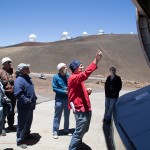
Personally I had never visited these facilities, not during my seven years on the mountain. This is something that had to change. I suspected that this was true of most of the West Hawaii Astronomy club membership. It is even more imperative in that one of the facilities, CSO, is to be decommissioned and dismantled in the next few years. Thus the goal of visiting at least a couple of the submillimeter facilities to see the other side of Mauna Kea astronomy.
When arranging the tour I contacted all three submillimeter facilities on the summit. I would have considered getting two out of three a success, I knew that there was no way I would manage to get all three scheduled for a single day. The submillimeter observatories have much smaller staffs than the large optical telescopes like Keck, thus providing a tour to a visiting group is much more difficult. In the end all three observatories were able to provide a tour on the same afternoon, something I am still surprised about. A great deal of gratitude is due to the folks who drove up the mountain on a Saturday to give our group a wonderful tour.

